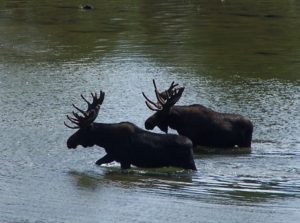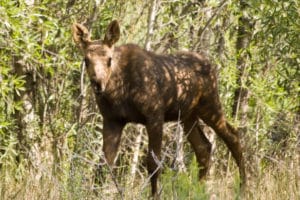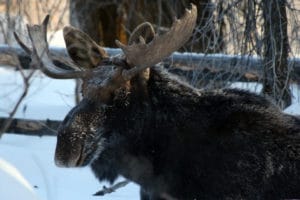How are moose doing? The short answer is, not very well. Why? That requires a long answer.
Moose appear to be a relative recent resident of Wyoming. Records of observations are lacking from the explorers and early travelers of the West. Moose are absent from Native American folklore and art in Wyoming, and moose appear to be lacking in the archaeological records. The earliest record appears to be from 1850 in the Jackson valley.

Northwest Wyoming is sort of a finger extending south of the boreal forests across southern Canada and the northern United States where moose are found. It may be that moose have recently (from an ecological time standpoint) expanded into Wyoming as part of the ebb and flow of a species at the periphery of its range. This happens as climate or other physical and biological influences provide and remove opportunity for a species at the edge of its distribution over long periods of time.
As with other big game, moose had become relatively abundant by the mid to late 1900s. Public pressure to have even more moose and very high harvest success compelled Wyoming Game and Fish biologists to manage the species conservatively. Hunting license quotas were low and the numbers of cows harvested were likely insufficient to limit herd size in many areas. Those lucky enough to draw a license also had to wait 5 years before they could apply again. Hunters experienced over 90% success harvesting an adult bull in many hunt areas.
This conservative management paradigm contributed to an over-abundance of moose. Moose are selective browsers, and in many areas where the information is available, they had a profound effect on their preferred plants, especially shrubs. Added stressors include parasites, loss and degradation of habitat, human development and activity, predation, and just being a big, black animal trying to live in an ever warming climate. The combination of factors has led to a steep decline in moose populations across many parts of the west. This happened concurrent with a similar trend in other species, such as mule deer and sage-grouse.
To quantify Wyoming’s moose situation, consider the following data. The statewide moose population estimate in 1989-91 was 12,500-13,000 animals. Hunting licenses for 36 hunt areas in 15 herds were 1600-2000, primarily for male moose. The harvest during that time period was 850-930 males and 500-730 antlerless animals (1350-1660 total) annually. That’s 11-13% of the population and probably 5-8% of the females, insufficient to control growth.

In contrast, the 2015 statewide population was estimated at 3470 animals, and the statewide population objective is now down to 4355. There were 397 licenses issued in 2015 across 37 hunt areas (5 of which were closed) in 10 herds. Some hunt areas have been combined to allow license holders much more land to hunt for moose scattered sparsely across the landscape. Harvest that year was 310 bulls and 42 antlerless animals. Moose populations and moose hunting dropped dramatically in a matter of decades. Reproduction appears to now be improving, but as counter intuitive as it may be to some, the populations in many herd units need to be controlled until forage plants have recovered.
The greatest decline in moose numbers has happened in that part of the state they have occupied the longest – mainly western, especially northwestern, Wyoming (that finger of boreal forests extending south). The moose population in the Bighorns is of a medium age compared to others, originating from introductions starting in 1948. Licenses and harvest there peaked in the early 2000s and are now down to about what they were in the late 1980s. Deciduous shrub and tree communities in the Bighorns are now generally in poor condition, due to a great degree from over-browsing.

Some are quick to blame wolves for the plight of moose in the state, and the wolf is certainly a moose predator. But the facts don’t support the contention that they are THE cause. First, moose in southwestern Wyoming and in other parts of the West, where there are no wolves, are having the same issues as those in northwestern Wyoming.
But, there is a more complex and interesting ‘backstory’. In the early 1990s, a researcher named Joel Berger, studying songbirds in willow communities in the Jackson area, noticed he was seeing many moose cows with no calves. It was long understood that, unlike female moose in other parts of their continental distribution who commonly twinned, Wyoming cow moose typically had single calves, indicating a reproductive (nutritional?) issue. Berger followed up on his observations by tracking (radio collared) cow moose and analyzing fresh female moose scat for progesterone levels, an indication of pregnancy rates.
He compared his results to a study in the late 1960s showing twinning rates of about 10 percent and pregnancy rates of about 90 percent. His research showed that, some 30 years or so later, twinning rates were less than 5 percent and pregnancy rates were around 75 percent. Berger documented in his research that malnutrition accounted for 60 percent of known adult cow deaths. Predation, roads, traffic fatalities, human hunting, and unknown factors accounted for the remaining 40 percent in roughly equal proportions.
The deduction was that nutritional plane of many cow moose was insufficient to support reasonable moose cow survival and reproduction. The condition of moose habitat in western Wyoming generally supports Berger’s conclusions. Berger’s findings, and the recognition that something was happening with moose populations, were before wolf numbers were large enough and distributed enough to be having an effect on moose across western Wyoming. The findings of WGFD research in 2005-2008 generally agree with Berger’s results and with WGFD survey data that is showing improved calf survival and recruitment.

